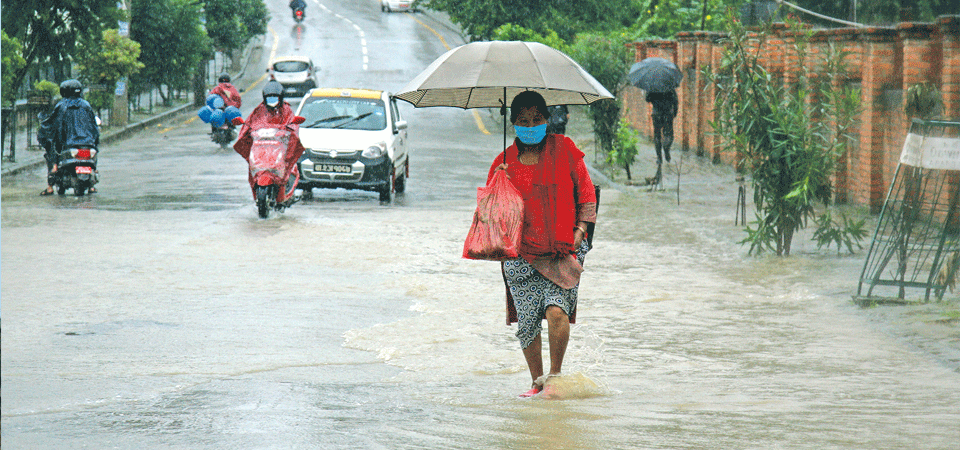Monsoon likely to be delayed by a week, above-normal rainfall predicted

By Kshitiz Siwakoti, Kathmandu, June 3: The Meteorological Forecasting Division (MFD) has predicted that the monsoon is likely to be delayed by a week this year. Generally, the monsoon season begins from June 10 and lasts till September 23 in Nepal.
Pratibha Manandhar, a senior meteorologist at the MFD, said that the monsoon is likely to arrive in Nepal by June 13 or slightly delay. “The monsoons should have reached the western coast of India by now but since it has been delayed it is possible that it could be delayed by around a week in Nepal too,” She said.
Monsoon had arrived in two days lately in 2019 and 2020. But in 2018, it had begun two days earlier than the normal onset date of June 10.
Meanwhile, the Department of Hydrology and Meteorology (DHM) has forecasted more than average rainfall in Nepal for this year. According to a report published by the DHM, the Provinces of Sudurpaschim, Karnali, Gandaki and Bagmati along with the Mid-Hills region and the Himalayan region of Province 1 is expected to receive about 35-65 per cent more than average rainfall. Similarly, the Terai region of Lumbini, Gandaki, Bagmati, and the western region of Province 2 is expected to receive average rainfall ranging from 35- 45 per cent within the average amount.
Finally diverging from the trend the Terai region of Province 1 and the eastern region of Province 2 is expected to receive less than average rainfall ranging between 35 - 45 per cent less than the average amount of rainfall.
“The regions that have rainfall ranging from 35 - 65 per cent above average means that, within this region, some places have the probability of receiving higher than average rainfall by only 35 percent whereas some places may receive above-average rainfall by more than 60 or at 65 per cent,” chief of climate Analysis Section of the DHM, Dr. Indira Kadel, said.
Eighty percent of all the rain in Nepal is received during the monsoon (June-September). The average amount of rainfall throughout the country has been estimated to be approximately 1600 mm although this varies from place to place. Such as Pokhara receives approximately 3,345 mm of rain annually and Mustang only receives less than 300 mm of rainfall every year.
Meteorologist at the MFD Samir Shrestha said that due to heavy rainfall throughout the country there are higher chances for floods and landslides to take place.
“Nepal has already been receiving pre-monsoon rains and the recent Cyclone Yaas which devastated Eastern India has also brought significant rainfall to Eastern parts of Nepal. This coupled with a higher amount of rainfall significantly increases the risk for flooding and landslides,” Shrestha said.
Undersecretary of the National Emergency Operation Centre (NEOC) under the Ministry of Home Affairs, Dil Kumar Tamang, said that a flood can only be predicted within 72 hours.
“The MFD can forecast the weather for the upcoming three days, and if they find that some region could be hit by floods, we alert the NEOC at the provincial level which is responsible for securing the area,” Tamang told The TRN Online.
Recent News

Do not make expressions casting dout on election: EC
14 Apr, 2022
CM Bhatta says may New Year 2079 BS inspire positive thinking
14 Apr, 2022
Three new cases, 44 recoveries in 24 hours
14 Apr, 2022
689 climbers of 84 teams so far acquire permits for climbing various peaks this spring season
14 Apr, 2022
How the rising cost of living crisis is impacting Nepal
14 Apr, 2022
US military confirms an interstellar meteor collided with Earth
14 Apr, 2022
Valneva Covid vaccine approved for use in UK
14 Apr, 2022
Chair Prachanda highlights need of unity among Maoist, Communist forces
14 Apr, 2022
Ranbir Kapoor and Alia Bhatt: Bollywood toasts star couple on wedding
14 Apr, 2022
President Bhandari confers decorations (Photo Feature)
14 Apr, 2022










